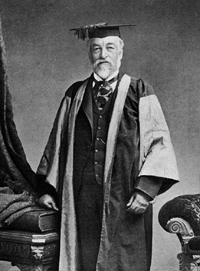Samuel Pierpont Langley
AvStop Magazine Online
Samuel Pierpont Langley
|

|
Samuel Pierpont Langley (1834 - 1906) is often used as a contrast to
the Wrights. Unlike the two brothers, Langley was highly-educated and had
more than ample funding in support of his efforts to develop an airplane.
His stature at Secretary of the Smithsonian Institution lent great credibility
to his efforts to build an airplane, as did his success with the unmanned
aerodromes. In particular, his Aerodrome No. 6 flew 4,200 feet at about
30 mph on November 28, 1896.
This unmanned tandem-wing craft employed a
lightweight steam engine for propulsion. The wings were set at a distinct
dihedral angle so that the craft was dynamically stable, capable of righting
itself when disturbed by a sideways breeze. There was no method of steering
this craft, nor would it have been easy to add any means to control the
direction the craft flew.
From the success of No. 6, Langley was able to convince the War Department
(a.k.a. Department of Defense) to contribute $50,000 toward the development
of a person-carrying machine. The Smithsonian contributed a like sum towards
Langley's efforts.
Charles Manley developed an extraordinary radial-cylinder
internal combustion engine that developed 52 horsepower for the man-carrying
Great Aerodrome. Langley felt it would be safest to fly over water, so
he spent almost half of his funds constructing a houseboat with a catapult
that would be capable of launching his new craft. |
The Great Aerodrome might have flown if Langley had chosen a
more traditional means of launching the craft from the ground. The pilot
still would have lacked any means of steering the plane, and so faced dangers
aplenty. But it might have at least gotten into the air. Unfortunately,
Langley chose to stick with his 'tried-and-true' approach of catapult launches.
The plane had to go from a dead stop to the 60 m.p.h. flying speed in only
70 feet. The stress of the catapult launch was far greater than the flimsy
wood-and-fabric airplane could stand. The front wing was badly damaged
in the first launch of October 7, 1903. A reporter
who witnessed the event claimed it flew "... like a handful of mortar."
Things went even worse during the second launch of December 9, 1903, where
the rear wing and tail completely collapsed during launch. Charles Manley
nearly drowned before he could be rescued from the wreckage and the ice-covered
Potomac river.
Needless to say, the Washington critics had a field day. The Brooklyn
Eagle quoted Representative Hitchcock as saying, "You tell
Langley for me ... that the only thing he ever made fly was Government
money." Representative Robinson characterized Langley as "a professor
... wandering in his dreams of flight ... who was given to building ...
castles in the air."
The War Department, in its final report on the Langley project, concluded
"we are still far from the ultimate goal, and it would seem as
if years of constant work and study by experts, together with the expenditure
of thousands of dollars, would still be necessary before we can hope to
produce an apparatus of practical utility on these lines." Eight days after
Langley's spectacular failure, a sturdy, well-designed
craft, costing about $1000, struggled into the air in Kitty Hawk, defining
for all time the moment when humankind mastered the skies.
In spite of 18 years of well-funded and concerted effort by Langley
to achieve immortality, his singular contribution to the invention of the
airplane was the pair of 30-lb aerodromes that flew in 1986. He died in
1906 after a series of strokes, a broken and disappointed man.
